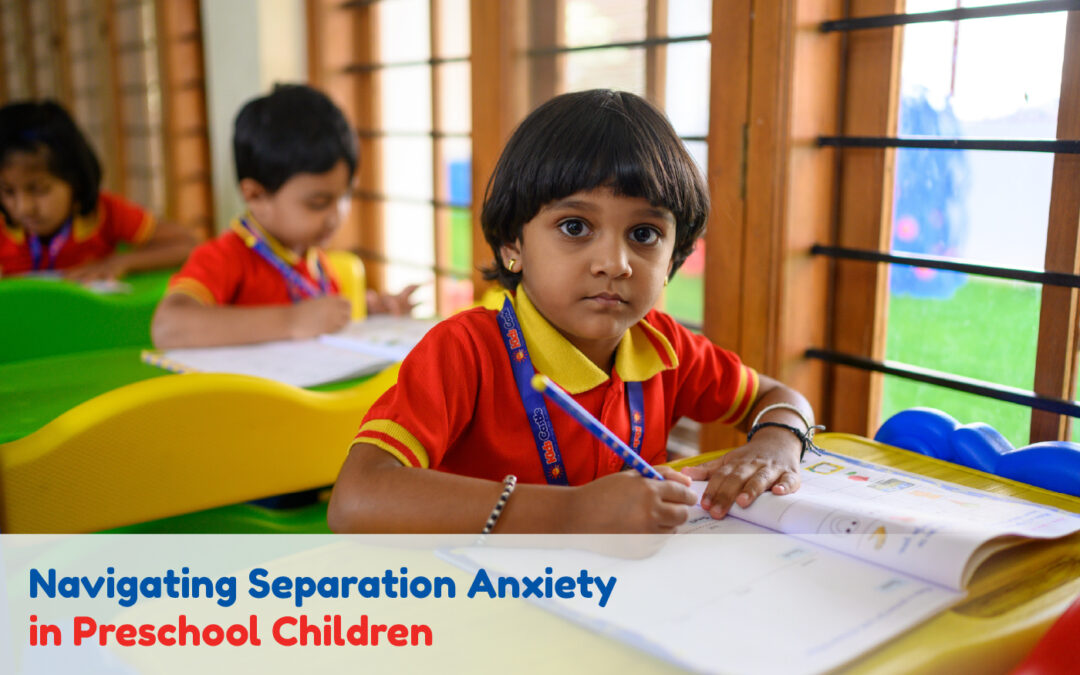Introduction:
Once upon a time, in a small, sunlit classroom filled with colourful drawings and the cheerful sounds of children’s laughter, there was a little boy named Kiran. Kiran was four years old, with bright eyes and a curious mind, eager to explore the world around him. But every morning, as his mother kissed him goodbye at the preschool gate, Kiran’s world would suddenly shrink. His eyes would fill with tears, and his small hands would cling to hers, unwilling to let go. This is a story familiar to many parents and caregivers, a tale of separation anxiety in preschool children, a journey of love, patience, and understanding.
Separation anxiety is a normal stage of development for young children, especially as they begin to navigate the world outside the comforting presence of their families. It’s a sign of deep bonds and healthy attachments, yet it can be challenging for both children and their caregivers.
In this blog let us try to recognize, understand, and identify ways to address separation anxiety with empathy and strategies. A caring parent can transform the journey into one of growth and confidence for their preschool children.
Understanding Separation Anxiety
Separation anxiety in preschool children manifests as distress and fear when they are away from their primary caregivers. It typically peaks between 1 and 3 years of age but can extend into the preschool years. Symptoms may include crying, clinging, tantrums, and expressions of fear about being apart from their loved ones.
This anxiety is rooted in the child’s developmental understanding of the world. Pre-schoolers are beginning to grasp the concept of time but still lack the full assurance that their caregiver will return once gone. Their imagination can worsen fears of the unknown, making separation more daunting.
Recognizing the Signs
The first step in navigating separation anxiety is recognizing the signs. Beyond the tears and tantrums, children may show some symptoms such as
- Reluctance to engage in previously enjoyed activities.
- Too concerned about the safety of a family member
- Refusing to go to school
- Reluctance to be alone
- Complaints about stomach aches, or headaches
- Being very clingy, even at home
- Temper tantrums during separation
Understanding these signs can help parents and educators tailor their approach to support the child.
Strategies for Easing Separation Anxiety
Establish a Goodbye Ritual
Create a consistent and quick goodbye ritual. This could be a special hug, a high-five, or a secret handshake. Rituals provide a sense of security and predictability, making the separation less scary for the child. The parent can also adopt an approach to say that the separation is only temporary.
Practice Separation
Short, gradual periods of separation can help ease anxiety. Start with leaving your child with a trusted caregiver for short durations and gradually increase the time apart. This helps build the child’s confidence and trust that you will return.
Keep Promises
Always say goodbye and reassure your child that you will return. Sneaking out can increase anxiety. Make sure to return at the time you promised, as this builds trust and security.
Create a Comfort Object
Allowing the child to keep a reminder of home or a comfort object can be soothing. This could be a photograph, a small toy, or a piece of the parent’s clothing.
Positive Reinforcement
Praise your child for their brave behaviour. Acknowledge their feelings but emphasize the positive aspects of their day and the fact that they were able to get through the separation.Try to inculcate a habit of sharing the days learnings, fun moments and celebrate them
Collaborate with Caregivers
Work closely with your child’s preschool teachers and caregivers. They can be invaluable allies in providing consistency and reassurance to your child during separations.
When to Seek Help
While separation anxiety is a normal part of development, if a child’s anxiety is severe, persists for an extended period, or interferes with their daily activities, it might be helpful to seek the advice of a pediatrician or a child psychologist. Professional guidance can provide strategies tailored to your child’s specific needs.
Conclusion:
Navigating separation anxiety in preschool children is a journey that requires patience, understanding, and a lot of love. Like little Kiran, many children face challenges in overcoming their fears of separation. But with the right support and love, they can learn to accept it as a way of life, and learn to value independence, resilience, and confidence in their abilities to explore the world on their own.
As parents and caregivers, our role is to guide them through this journey, providing the security and encouragement they need to step out with confidence, knowing that their loved ones are always there, ready to welcome them back with open arms.
For more informative blogs visit our page.
Please subscribe to our YouTube channel.

